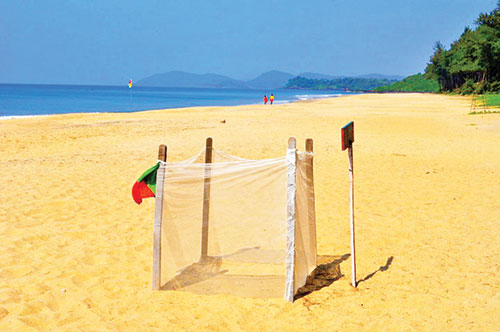
The Goa Coastal Zone Management Authority recently drew up a Sea Turtle Nesting and Habitat Management Plan that was prepared with the assistance of the Centre for Environment Education (CEE Goa State office), an organisation recognised by the Union Ministry of Environment. The aim of the sea turtle nesting habitat conservation plan is to protect, conserve the turtles and their habitat while enabling sustainable development in and around the turtle nesting beaches of Morjim, Mandrem, Agonda and Galgibaga.
In that plan it is proposed that each of the beaches will have clear demarcation of the extent and boundary of the geographical/spatial space where the management plan shall apply such as NO TAKE Zone, Sustainable Tourism Zone and Fisheries Livelihoods Zone.
This will cover the terrestrial and marine/estuarine areas of the beach.
1Terrestrial boundary: Will be considered from the low tide line (LTL) up to high tide line (HTL) and further landward up to at least 500 metres from HTL. The intertidal areas will also be part of the terrestrial area.
2 Sand-dunes are integral and a vital ecosystem for turtle nesting. The sand dunes shall be considered as ‘no entry’ areas for recreation or any other physical activity.
3 The toe area of sand dune shall be considered as a ‘no walking – no entry‟ area to reduce risk of compaction of the critical nesting spots and protect physical damage to sand dune by beach users. Such a ‘no entry area’ along the length of the sand dune shall be maintained as ‘3 to 5 meter’ from toe of sand-dune towards the beach / seawards side.
4The entire length of the beach wherever the turtles are nesting shall be considered for application of this plan. The precise boundaries shall be identified based on where the turtle nests have been found/located. At least, 3 to 5 km. continuous shoreline length of the beach may primarily be considered as the turtle nesting beach habitat space in each location.
4 Marine and estuarine boundary: Shall be considered from the tide line (LTL) up to at least 500 metre seaward side from LTL. The mouth of estuarine, creek areas shall also be considered as part of the boundary.
4The sea turtle nesting habitat plan shall apply in all the CRZ categories falling within the geographical/spatial space where the plan is proposed for implementation. This may mean that the area under turtle nesting habitat management may not just fall in CRZ1, but also in CRZ 3, CRZ2, CRZ4 areas which may be in the beach stretch.
Beach space and shack
management
* GCZMA was assigned the task of evolving a management plan and to identify beach spaces and divide them into go and ‘no go areas’, in association with the Goa Forest Department, local stakeholders and other line departments.
* Current practice at Morjim beach is that a 600 metre stretch near the river mouth in Tembvaddo area is exclusively earmarked as No –Take Area (Turtle conservation reserve). No activity of any nature that possibly hampers the nesting behaviour is allowed. Whereas northern space towards Vithaldas Vaddo is allocated for makeshift shacks for a commercial livelihood activity. This arrangement is working well without any conflict for several years now.
* Shacks permitted in the ‘Sustainable Tourism Area’, where commercial activities are permitted, must be strictly monitored and as per the suggested norms and guidelines.
* It is suggested that there must be at least 20 metres distance from each of the shacks. This requirement is to provide sufficient space without any physical barriers for sea turtles to roam around in search of nesting space in case she comes in this area for nesting.
* The current number of shacks allotted on beaches such as Morjim and Mandrem shall continue to run their business in accordance with the general and specific guidelines prescribed in this plan.
* In Agonda and Galgibaga, the Government of Goa has decided not to permit any tourism shacks on the beach. This shall continue.
* Turtles have tendencies to crawl beyond the High Tide Line (HTL) and lay nests on the dunes. It is important that while erecting the make-shift shack, no changes in beach morphology are done.
* In addition to it, all conditions prescribed by the Goa Forest Department must be followed.
* In the area designated as No-Take Area, no activity which has possibility of hampering nesting behaviour is allowed.
* As per the Beach Carrying Capacity Report, the area within NDZ is allowed to be used for putting up temporary huts.
* However, as mentioned in the report, Agonda has exceeded its carrying capacity and no new temporary structures are allowed.
* In Morjim area abutting conservation reserve has been excluded and no temporary shacks are allowed.
* Mandrem does not have effective in-situ conservation, it is proposed that a 600 metre beach length is identified and designated as Conservation reserve. Once the area is earmarked, area abutting this may be excluded from temporary shacks and huts.
* Galgibaga is under the control of Goa Forest Department.
* All recommendations done in that report shall be in addition to what is prescribed for the beaches of Agonda and Galgibaga.
